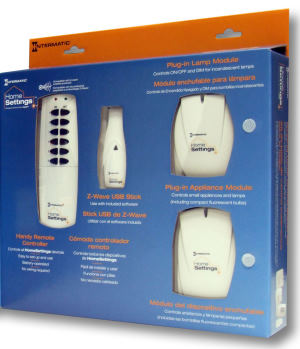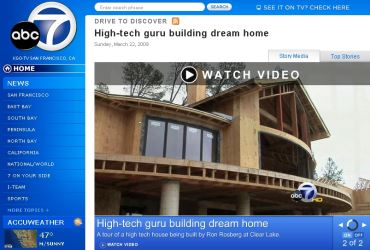 The holy grail for most tech enthusiasts is home automation, the ability to control one's environment from anywhere in the home seamlessly and easily. The promise of this technology lies in the Z-wave communications standard adopted by more than 100 companies, including Intermatic, who makes the Home Settings lines of home automation products.
The holy grail for most tech enthusiasts is home automation, the ability to control one's environment from anywhere in the home seamlessly and easily. The promise of this technology lies in the Z-wave communications standard adopted by more than 100 companies, including Intermatic, who makes the Home Settings lines of home automation products.
 Z-wave is a open communications standard which uses mesh technology to extend the communications range between devices, meaning that Z-wave devices also act as repeaters, extending the normal 50 foot range of these devices to an entire home or building. Also, the programs stored on one device can be accessed from other devices in the mesh network.
Z-wave is a open communications standard which uses mesh technology to extend the communications range between devices, meaning that Z-wave devices also act as repeaters, extending the normal 50 foot range of these devices to an entire home or building. Also, the programs stored on one device can be accessed from other devices in the mesh network.
Unlike previous generation home automation products such as X10 and UPB, Z-wave devices communcate wirelessly and bi-directionally, allowing the modules to be programmed and sychronized remotely. In our test environment, we wanted to set a "TV Scene" in the living room where the lights next to the couch dimmed, and those would reflect into the TV turned off completely. To achieve this, we completed the following steps:
- Plug in the outlet and socket modules that control the lights
- Press the INCLUDE button on the controller within 6 feet of each new module, and then turn the light on with the module button (this process includes the module in the mesh network and now any remote can control it).
- Press and hold the control button(s) that you want to use to set the scene (a scene can be just one device or several). Then press and hold INCLUDE and while holding the INCLUDE button down, turn the light on or off or set a dim level at the module controller.
- Add additional modules to the same button
- Add the same modules to other buttons.
 Once the scene is programmed, you can press ON or OFF to instantly turn the scene on or off, or you can hold ON to slowly increase the brightness of all lights in the scene, or hold OFF to slowly dim them. Also, once a "scene" is programmed on one controller, the entire scene can be accessed from another controller via the mesh network.
Once the scene is programmed, you can press ON or OFF to instantly turn the scene on or off, or you can hold ON to slowly increase the brightness of all lights in the scene, or hold OFF to slowly dim them. Also, once a "scene" is programmed on one controller, the entire scene can be accessed from another controller via the mesh network.
In less than 30 minutes after opening the packages, the first step in our home automation dream was realized, intelligent lighting control in the living room. We liked what we saw, but it just wet our appetite for more. Stay tuned for more articles on Zwave technology for the home.

 Gadget Gurus technology reviews are heard and read by millions of people across the United States, including more than a dozen
Gadget Gurus technology reviews are heard and read by millions of people across the United States, including more than a dozen 